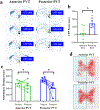Inactivation of the thalamic paraventricular nucleus promotes place preference and sucrose seeking in male rats
- PMID: 35524009
- PMCID: PMC9296579
- DOI: 10.1007/s00213-022-06160-2
Inactivation of the thalamic paraventricular nucleus promotes place preference and sucrose seeking in male rats
Abstract
Rationale: The experience of reward entails both positive affect and motivation. While the brain regions responsible for these distinct aspects of reward are dissociable from each other, the paraventricular nucleus of the thalamus (PVT) may play a role in both.
Objectives: To investigate the role of the PVT in both affect and motivation, and to identify neuropeptides that might mediate these effects.
Methods: Male rats were tested for conditioned place preference following temporary inactivation of the anterior or posterior PVT with local injections of the GABAB and GABAA agonists, baclofen + muscimol. They were tested for sucrose seeking under a fixed ratio 3 (FR3) schedule of reinforcement and after extinction, following injection into the posterior PVT of baclofen + muscimol or saline vehicle. Finally, quantitative real-time PCR was used to examine local neuropeptide gene expression following injection into the posterior PVT of baclofen + muscimol or saline vehicle.
Results: Conditioned place preference was induced by temporary inactivation of the posterior but not anterior PVT. While sucrose seeking under an FR3 schedule of reinforcement was unaffected by inactivation of the posterior PVT, reinstatement of sucrose seeking was promoted by posterior PVT inactivation. Local gene expression of pituitary adenylate cyclase-activating polypeptide (PACAP), but not enkephalin or neurotensin, was reduced following inactivation of the posterior PVT.
Conclusions: Temporary inactivation of the posterior PVT affects both affect and motivation as well as local gene expression of PACAP. These results suggest that the posterior PVT is one brain region that may participate in both major aspects of reward.
Keywords: Anterior; Baclofen; Conditioned place preference; Fixed ratio; Muscimol; Operant; PACAP; Posterior; Reinstatement; mRNA.
© 2022. The Author(s), under exclusive licence to Springer-Verlag GmbH Germany, part of Springer Nature.
Conflict of interest statement
Conflict of Interest:
The authors declare that they have no conflict of interest.
Figures




Similar articles
-
Transient inactivation of the posterior paraventricular nucleus of the thalamus blocks cocaine-seeking behavior.Neurosci Lett. 2015 Nov 3;608:34-9. doi: 10.1016/j.neulet.2015.10.016. Epub 2015 Oct 9. Neurosci Lett. 2015. PMID: 26455867 Free PMC article.
-
Pituitary Adenylate Cyclase-Activating Polypeptide-27 (PACAP-27) in the Thalamic Paraventricular Nucleus Is Stimulated by Ethanol Drinking.Alcohol Clin Exp Res. 2018 Sep;42(9):1650-1660. doi: 10.1111/acer.13826. Epub 2018 Jul 20. Alcohol Clin Exp Res. 2018. PMID: 29969146 Free PMC article.
-
Transient inactivation of the paraventricular nucleus of the thalamus enhances cue-induced reinstatement in goal-trackers, but not sign-trackers.Psychopharmacology (Berl). 2018 Apr;235(4):999-1014. doi: 10.1007/s00213-017-4816-1. Epub 2017 Dec 28. Psychopharmacology (Berl). 2018. PMID: 29285634 Free PMC article.
-
Circuit and neuropeptide mechanisms of the paraventricular thalamus across stages of alcohol and drug use.Neuropharmacology. 2021 Oct 15;198:108748. doi: 10.1016/j.neuropharm.2021.108748. Epub 2021 Aug 11. Neuropharmacology. 2021. PMID: 34389397 Free PMC article. Review.
-
Drug Seeking and Relapse: New Evidence of a Role for Orexin and Dynorphin Co-transmission in the Paraventricular Nucleus of the Thalamus.Front Neurol. 2018 Aug 28;9:720. doi: 10.3389/fneur.2018.00720. eCollection 2018. Front Neurol. 2018. PMID: 30210441 Free PMC article. Review.
Cited by
-
Zona incerta dopamine neurons encode motivational vigor in food seeking.Sci Adv. 2023 Nov 15;9(46):eadi5326. doi: 10.1126/sciadv.adi5326. Epub 2023 Nov 17. Sci Adv. 2023. PMID: 37976360 Free PMC article.
-
Quantifying conditioned place preference: a review of current analyses and a proposal for a novel approach.Front Behav Neurosci. 2023 Aug 24;17:1256764. doi: 10.3389/fnbeh.2023.1256764. eCollection 2023. Front Behav Neurosci. 2023. PMID: 37693282 Free PMC article.
-
Pituitary adenylate cyclase-activating polypeptide (PACAP)overexpression in the paraventricular nucleus of the thalamus alters motivated and affective behavior in female rats.Alcohol Clin Exp Res (Hoboken). 2025 Mar;49(3):539-550. doi: 10.1111/acer.15525. Epub 2025 Jan 2. Alcohol Clin Exp Res (Hoboken). 2025. PMID: 39746847
-
Pituitary adenylate cyclase-activating polypeptide (PACAP) in the paraventricular nucleus of the thalamus: Influence on binge-type eating in male and female mice.Res Sq [Preprint]. 2024 Apr 2:rs.3.rs-4145128. doi: 10.21203/rs.3.rs-4145128/v1. Res Sq. 2024. Update in: Psychopharmacology (Berl). 2025 Feb;242(2):413-426. doi: 10.1007/s00213-024-06692-9. PMID: 38645077 Free PMC article. Updated. Preprint.
-
Activation of Metabotropic Glutamate Receptor 3 Modulates Thalamo-accumbal Transmission and Rescues Schizophrenia-Like Physiological and Behavioral Deficits.Biol Psychiatry. 2024 Aug 1;96(3):230-242. doi: 10.1016/j.biopsych.2023.11.023. Epub 2023 Dec 5. Biol Psychiatry. 2024. PMID: 38061467 Free PMC article.
References
MeSH terms
Substances
Grants and funding
LinkOut - more resources
Full Text Sources

